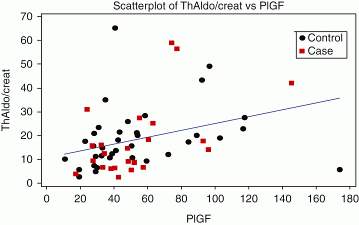SFEBES2014 Poster Presentations Steroids (39 abstracts)
Systemic availability of placental growth factor correlates with urinary tetrahydroaldosterone excretion in normal and preeclamptic pregnancy
Gemma Currie 1 , Nicole Eisele 2 , Heather Small 1 , Genevieve Escher 2 , Carine Gennari-Moser 2 , David Carty 1 , Markus Mohaupt 2 & Delles Christian 1
1Institute of Cardiovascular and Medical Sciences, BHF Glasgow Cardiovascular Research Centre, University of Glasgow, Glasgow, UK; 2Department of Nephrology and Hypertension, Bern University Hospital, Bern, Switzerland.
Background: Aldosterone levels are elevated in normal pregnancy but fall despite volume contraction in preeclampsia. Vascular endothelial growth factor (VEGF) and soluble fms-like tyrosine kinase 1 (sFlt-1) have been implicated in this phenomenon in vitro and in animal work. Low placental growth factor (PlGF), which is closely linked to VEGF signalling, identifies women at risk of preeclampsia between 20 and 35 weeks gestation. We aimed to examine these relationships in human subjects in early pregnancy.
Methods: We examined levels of aldosterone and PlGF at gestational weeks 14–16 in women who had previously taken part in the Proteomics in Preeclampsia (PIP) Study; a longitudinal study of 2500 pregnancies investigating early pregnancy biomarkers to predict preeclampsia. Stored urine and plasma samples were obtained from 48 cases and 48 matched pregnant controls. Urinary tetrahydroaldosterone (THAldo) excretion was measured by gas chromatography–mass spectrometry (GC–MS) and PlGF by ELISA.
Results: Age, BMI, and booking systolic blood pressure were similar between groups. In line with findings of the PIP study, booking diastolic blood pressure was higher among women who went on to develop preeclampsia (72 mmHg, IQR 54–82, cf. 70 mmHg, IQR 56–78 by Mann–Whitney, P=0.0452.) Urinary THAldo:creatinine ratio was significantly lower among cases than controls (9.22 μg/mmol, IQR 1.41–16.6, cf. 15.96 μg/mmol, IQR 2.76–22.61 by t-test, P=0.024). Whilst the groups did not show any significant difference in early pregnancy PlGF level, we identified a linear relationship between PlGF and THAldo in both cases and controls (Spearman’s rank correlation 0.415, P=0.001).

Conclusion: THAldo and PlGF are closely linked in early pregnancy. Given the critical role of THAldo in pregnancy, these data suggest that in women destined to develop preeclampsia low THAldo rather than PlGF is causal extending the findings of previous animal work to human subjects.




